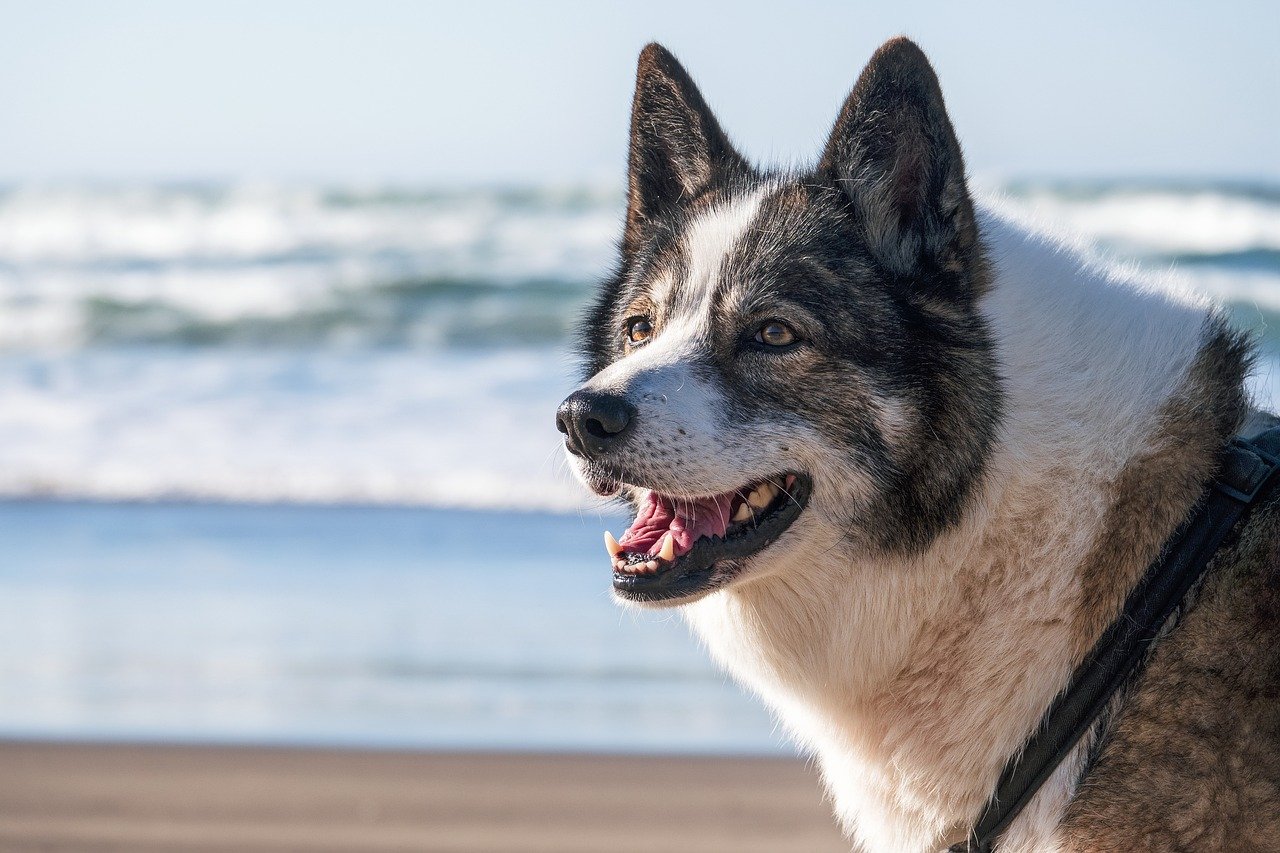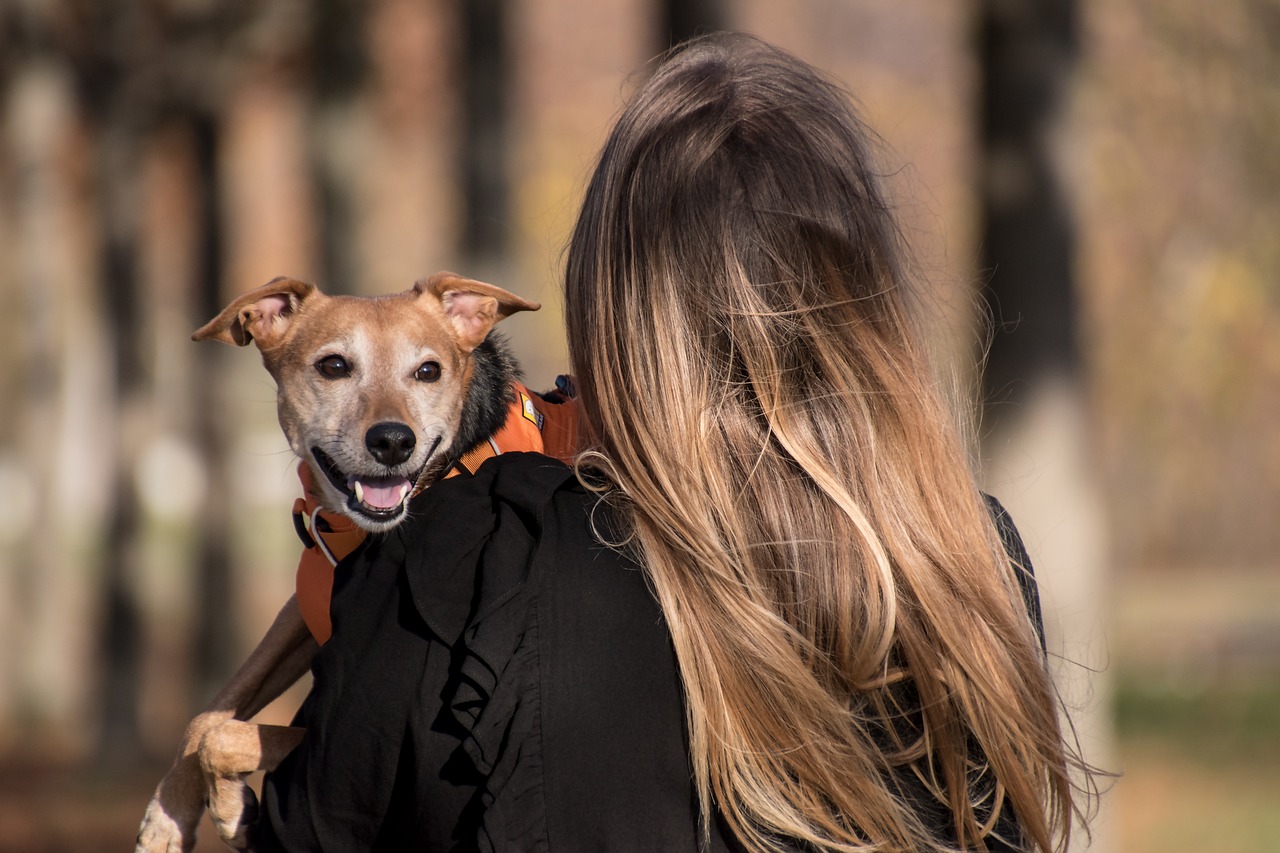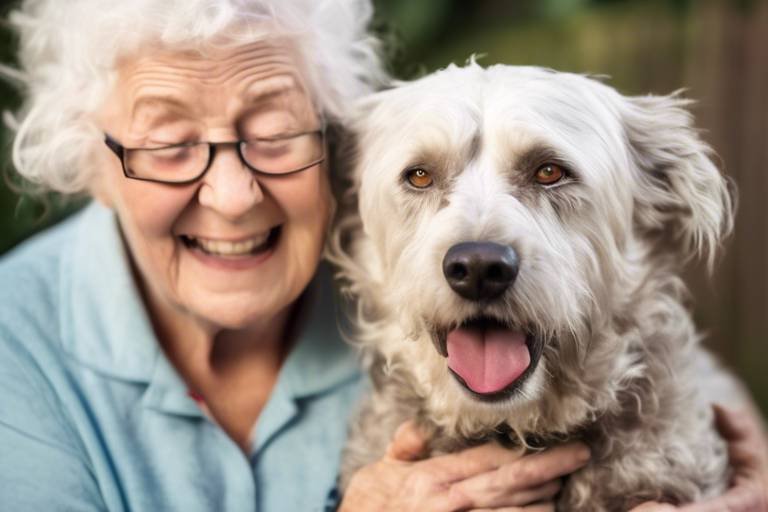Recognizing and Managing Senior Pet Fatigue
As our furry companions age, they often face a myriad of changes that can affect their overall health and well-being. One of the most significant issues that arise is fatigue. Just like humans, senior pets can experience a decline in energy levels, making it essential for pet owners to recognize and manage these changes effectively. Understanding the signs of fatigue not only helps in improving their quality of life but also allows for timely interventions that can prevent further health complications.
Senior pet fatigue can be a subtle yet alarming sign that your beloved pet may be struggling. It’s not always easy to detect; sometimes, it creeps up on us like a shadow. Imagine your once playful pup, now lounging more than playing, or your independent cat, now seeking the comfort of their bed more often than not. These changes can be signs of underlying health issues or simply the natural aging process. Therefore, it’s crucial to stay vigilant and proactive.
In this article, we will explore the various aspects of senior pet fatigue, from understanding its signs to effective management strategies. By the end, you’ll be equipped with the knowledge to ensure your senior pet remains comfortable and happy in their golden years. So, let’s dive into the world of senior pet fatigue and discover how we can make a difference in their lives!
Understanding how age affects energy levels in pets is key to identifying fatigue. Senior pets often experience fatigue differently than their younger counterparts. While a young dog may bounce back quickly after playtime, an older dog might take longer to recover, appearing sluggish or less enthusiastic. This is due to various factors, including decreased muscle mass, joint issues, and metabolic changes. Recognizing these differences can help you pinpoint when your pet is struggling and needs a little extra care.
Recognizing the signs of fatigue in senior pets can help owners intervene early and effectively. Some common symptoms include:
- Decreased Activity: If your pet is less active than usual, it could be a sign of fatigue.
- Reluctance to Play: A once playful pet may suddenly show disinterest in games or walks.
- Changes in Sleeping Patterns: Observe if your pet is sleeping more or less than they typically do.
Behavioral changes can often indicate fatigue. For instance, if your pet is more irritable or withdrawn from social interactions, it may be time to investigate further. Just like humans, pets can experience mood swings. Increased irritability can be a cry for help, signaling that something isn't quite right. Being aware of these shifts in behavior is crucial for timely interventions.
A decrease in appetite can often accompany fatigue. Monitoring your pet's eating habits is essential, as changes may signal underlying health issues or discomfort. If your pet suddenly turns their nose up at their favorite food, it might not just be a picky moment but a sign that they are feeling unwell.
Senior pets may sleep more or less than usual. Understanding these changes can help you determine if your pet is experiencing fatigue or other health concerns. If they are sleeping excessively, it might be their body’s way of coping with fatigue. Conversely, if they seem restless or unable to settle down, it could indicate discomfort or anxiety.
Physical symptoms of fatigue may include limping, difficulty standing, or excessive panting. Recognizing these signs can prompt timely veterinary evaluations. If your pet seems to struggle with basic movements, it’s essential to consult with a veterinarian to rule out any serious health conditions.
If fatigue persists or worsens, consulting a veterinarian is vital. Professional assessment can help identify any underlying health issues requiring attention. It’s always better to err on the side of caution when it comes to our pets’ health. A quick visit to the vet can provide peace of mind and ensure your furry friend receives the care they need.
Veterinarians may recommend various diagnostic tests to determine the cause of fatigue. Common tests include:
- Blood Tests: To check for underlying health issues.
- X-rays: To assess bone and joint health.
- Ultrasounds: To evaluate internal organs.
Treatment options for managing senior pet fatigue vary based on the underlying cause. Owners should be informed about potential therapies, medications, and lifestyle changes that can help. Whether it’s adjusting their diet, incorporating supplements, or modifying their exercise routine, every little change can contribute to their overall well-being.
Enhancing the quality of life for senior pets involves creating a comfortable environment, providing proper nutrition, and engaging in gentle exercise to combat fatigue. A cozy bed, a warm spot by the window, and a calm atmosphere can significantly improve their mood and energy levels.
A balanced diet is essential for senior pets. Nutritional adjustments can help manage fatigue and support overall health, making it easier for pets to maintain energy levels. Consulting with your veterinarian about the best diet for your senior pet can make a world of difference.
Incorporating gentle exercise into a senior pet’s routine can help combat fatigue. Short, frequent walks or play sessions can stimulate energy without overwhelming them. Think of it as a gentle stroll through a beautiful park rather than a marathon; it’s about quality, not quantity.
Q: How can I tell if my senior pet is fatigued?
A: Look for signs like decreased activity, reluctance to play, changes in appetite, and altered sleeping patterns.
Q: When should I consult a veterinarian about my pet's fatigue?
A: If your pet's fatigue persists or worsens, it's important to seek professional advice to rule out any serious health issues.
Q: What dietary changes can help manage my pet's fatigue?
A: A balanced diet tailored to your pet's age and health condition can significantly improve their energy levels. Consult your vet for specific recommendations.
Q: Are there specific exercises suitable for senior pets?
A: Yes! Gentle exercises like short walks or light play sessions are ideal for senior pets to help them stay active without overexerting themselves.

Understanding Senior Pet Fatigue
This article explores the signs of fatigue in senior pets, the importance of recognizing these symptoms, and effective management strategies to enhance their quality of life.
When it comes to our furry friends, the golden years can often feel like a different world. Senior pets experience fatigue in ways that might surprise even the most seasoned pet owners. Just like humans, as pets age, their bodies undergo significant changes. Imagine a once sprightly pup now moving at a leisurely pace; it’s not just a change in speed but a shift in energy dynamics. Understanding how age affects energy levels is crucial for identifying when your pet may be struggling.
As pets transition into their senior years, their muscle mass and metabolism naturally decline. This can lead to a noticeable drop in energy levels, making them less eager to engage in activities they once loved. It’s essential to recognize that this fatigue isn't just a sign of laziness or disinterest; it’s often a reflection of their changing physical condition. For instance, a senior dog might prefer lounging on the couch rather than chasing after a ball, not because they don’t want to play, but because their body is signaling them to take it easy.
Moreover, senior pets can also face underlying health issues that contribute to fatigue. Conditions such as arthritis, heart disease, or diabetes can all affect a pet’s stamina and willingness to engage in physical activity. Therefore, understanding senior pet fatigue requires a holistic view: paying attention not just to their energy levels but also to their overall health. Owners should be vigilant and observant, as these signs can sometimes be subtle yet significant.
To further illustrate, let’s consider some common factors that can contribute to fatigue in senior pets:
- Physical Changes: Just like us, pets experience wear and tear on their bodies. Joint stiffness and muscle weakness can make even short walks feel like a marathon.
- Health Conditions: Chronic diseases can sap energy. Regular vet check-ups can help catch these issues early.
- Emotional Well-being: Changes in their environment or routine can lead to stress, which can manifest as fatigue.
In summary, recognizing and understanding senior pet fatigue is not just about noticing changes in energy levels; it’s about being an advocate for their well-being. By keeping a close eye on their behavior and health, you can ensure that your furry companion enjoys their golden years to the fullest. Remember, a little extra love and attention can go a long way in making their twilight years as joyful and comfortable as possible.
Recognizing the signs of fatigue in senior pets can help owners intervene early. Symptoms may include decreased activity, reluctance to play, and changes in sleeping patterns.
Behavioral changes can indicate fatigue. Owners should be aware of shifts in their pet’s usual behavior, such as increased irritability or withdrawal from social interactions.
A decrease in appetite can often accompany fatigue. Monitoring eating habits is essential, as changes may signal underlying health issues or discomfort.
Senior pets may sleep more or less than usual. Understanding these changes can help owners determine if their pet is experiencing fatigue or other health concerns.
Physical symptoms of fatigue may include limping, difficulty standing, or excessive panting. Recognizing these signs can prompt timely veterinary evaluations.
If fatigue persists or worsens, consulting a veterinarian is vital. Professional assessment can help identify any underlying health issues requiring attention.
Veterinarians may recommend various diagnostic tests to determine the cause of fatigue. Blood tests, X-rays, or ultrasounds can provide insight into your pet's health.
Treatment options for managing senior pet fatigue vary based on the underlying cause. Owners should be informed about potential therapies, medications, and lifestyle changes that can help.
Enhancing the quality of life for senior pets involves creating a comfortable environment, providing proper nutrition, and engaging in gentle exercise to combat fatigue.
A balanced diet is essential for senior pets. Nutritional adjustments can help manage fatigue and support overall health, making it easier for pets to maintain energy levels.
Incorporating gentle exercise into a senior pet’s routine can help combat fatigue. Short, frequent walks or play sessions can stimulate energy without overwhelming them.
Q: How can I tell if my senior pet is fatigued?
A: Look for signs like decreased activity, reluctance to play, changes in appetite, and altered sleeping patterns.
Q: When should I consult a veterinarian?
A: If your pet's fatigue persists or worsens, it's essential to seek professional help to rule out any underlying health issues.
Q: What dietary changes can help manage my senior pet's fatigue?
A: A balanced diet rich in nutrients can support overall health. Consult your vet for specific recommendations tailored to your pet's needs.

Common Signs of Fatigue
Recognizing the signs of fatigue in senior pets is essential for their well-being. Just like humans, our furry friends can exhibit various symptoms when they're feeling worn out or unwell. It's crucial to be observant, as these signs can sometimes be subtle yet significant. For instance, you might notice your pet is not as enthusiastic about their daily walks or playtime. Instead of bounding towards the door, they may linger behind, looking less energetic than usual. This reluctance to engage in activities they once loved can be a telltale sign of fatigue.
Another common indicator is a noticeable change in sleeping patterns. Senior pets tend to sleep more, but if you find your pet sleeping excessively or, conversely, struggling to settle down at night, it could be a sign of fatigue or discomfort. Pay close attention to how much time they spend snoozing on their favorite spot versus being active. Additionally, if your pet seems to be waking up more frequently during the night, it might be their way of signaling that something is off.
Behavioral changes can also be a significant clue. If your once-social pet starts to withdraw from interactions, it may indicate they are feeling fatigued or even in pain. You might notice them becoming more irritable or less tolerant of handling and cuddles. These shifts in behavior can be concerning and should not be ignored. It's important to remember that while some changes are a natural part of aging, others can signify underlying health issues that need addressing.
Moreover, a decrease in appetite is often associated with fatigue. If your pet shows less interest in their food or you find that their bowl is often full, it’s time to investigate further. Sometimes, this can be due to dental problems, nausea, or other health conditions that could be causing discomfort. Keeping a close eye on their eating habits can provide valuable insights into their overall health status.
Lastly, watch for any physical symptoms that may accompany fatigue. Limping, difficulty standing up, or excessive panting can be signs that your pet is struggling more than usual. These symptoms can be alarming and should prompt a visit to the vet for a thorough evaluation. Remember, our pets rely on us to notice these changes and advocate for their health. By being vigilant and proactive, you can ensure your senior pet enjoys their golden years with comfort and joy.
- What is the average lifespan of senior pets? Senior pets are typically considered to be those over the age of 7, but this can vary by breed. Larger breeds often age faster than smaller ones.
- How can I tell if my pet is in pain? Signs of pain can include changes in behavior, reluctance to move, excessive vocalization, or changes in appetite.
- What should I do if I notice signs of fatigue in my pet? If you observe persistent signs of fatigue, it’s essential to consult your veterinarian for a thorough examination and guidance.
- Can diet affect my senior pet's energy levels? Absolutely! A balanced diet tailored to your pet's age and health needs can significantly impact their energy and overall well-being.
Behavioral Changes
As our furry companions age, their behavior can shift in ways that might surprise us. Just like humans, senior pets experience changes in mood, energy levels, and social interactions. These can be subtle or pronounced, and they often serve as important indicators of fatigue or underlying health issues. For instance, if your once-playful pup suddenly becomes less interested in chasing after their favorite ball, it might be a sign that they are feeling more tired than usual.
One of the most noticeable changes can be increased irritability. You might find that your pet, who used to be the life of the party, now prefers to lounge alone in their bed. This withdrawal from social interactions is not just a quirky phase; it can indicate that your pet is feeling overwhelmed or fatigued. It’s essential to observe how your pet interacts with family members and other pets. Are they snapping at the kids when they get too close, or do they seem to avoid playtime altogether? These shifts in behavior are crucial clues that should not be overlooked.
Additionally, you may notice your senior pet exhibiting signs of anxiety or restlessness. Instead of curling up for a nap, they might pace around the house or seem unable to settle down. This can be particularly concerning if it’s a drastic change from their usual habits. Remember, our pets communicate through their actions, and a sudden change in behavior can often be a cry for help. It's important to create a calm and safe environment for them, filled with cozy spots where they can retreat and feel secure.
Furthermore, keep an eye out for any changes in their routine. Senior pets may alter their sleeping patterns, leading to either excessive sleeping or insomnia. If your pet is sleeping more than usual, it could be their body's way of coping with fatigue. Conversely, if they seem restless at night, it might be due to discomfort or anxiety. Understanding these behavioral changes is key to providing the best care for your aging pet.
In summary, recognizing behavioral changes in senior pets is essential for ensuring their well-being. By being attentive to their moods and interactions, you can help identify when they may be experiencing fatigue or other health issues. Just like a detective piecing together clues, being observant will empower you to take action and seek help when necessary.
- What are the early signs of fatigue in senior pets? Early signs can include decreased activity levels, reluctance to play, and changes in sleeping patterns.
- How can I help my senior pet with fatigue? Providing a balanced diet, gentle exercise, and a comfortable living environment can significantly help manage fatigue.
- When should I consult a veterinarian about my pet's fatigue? If fatigue persists or worsens, it's essential to consult a veterinarian for a professional assessment.
- Can behavioral changes indicate something serious? Yes, significant behavioral changes can be a sign of underlying health issues, so it's important to monitor them closely.
Changes in Appetite
When it comes to our beloved senior pets, noticing can be one of the most telling signs that something might be amiss. Just like humans, pets can experience fluctuations in their eating habits as they age. However, these changes can often be subtle, making it crucial for pet owners to be vigilant. For instance, if your once-enthusiastic eater suddenly turns their nose up at their favorite kibble, it’s time to take note. This could be a sign of fatigue or even an underlying health issue.
Some common reasons for changes in appetite among senior pets include dental problems, digestive issues, or even emotional distress. Imagine if you had a toothache; would you want to munch on your favorite snacks? Similarly, your pet may be reluctant to eat if they’re experiencing discomfort. Moreover, senior pets might also be less active, leading to a natural decrease in their caloric needs. However, this doesn’t mean that a decreased appetite should be ignored. In fact, it’s essential to monitor their food intake closely and consult a veterinarian if significant changes occur.
To help you better understand the potential implications of appetite changes, consider the following table that outlines various scenarios:
| Change in Appetite | Possible Reasons | Recommended Action |
|---|---|---|
| Increased appetite | Parasites, diabetes, or other health issues | Consult a veterinarian |
| Decreased appetite | Dental issues, nausea, or emotional distress | Monitor closely; consult a vet if persistent |
| Refusal to eat | Serious health concerns, pain, or depression | Seek immediate veterinary attention |
It's also important to note that changes in appetite can be accompanied by other symptoms. For example, if your pet is eating less and also seems lethargic or withdrawn, it might indicate a more serious problem. In such cases, it’s always better to err on the side of caution. Regular check-ups and open communication with your veterinarian can help you stay ahead of potential issues.
In conclusion, keeping an eye on your senior pet’s appetite is vital for their health and well-being. By recognizing and addressing changes early, you can ensure that your furry friend continues to enjoy a happy and fulfilling life, free from discomfort and fatigue.
- What should I do if my senior pet refuses to eat? If your pet refuses to eat for more than 24 hours, consult your veterinarian to rule out any serious health issues.
- Can changes in diet affect my senior pet's appetite? Yes, changes in diet can significantly impact your pet's appetite, especially if the new food is not palatable or suitable for their needs.
- How can I encourage my senior pet to eat? Try warming their food, adding some broth, or offering smaller, more frequent meals to stimulate their appetite.
Altered Sleeping Patterns
As our furry friends age, their sleeping habits can undergo significant changes. Just like humans, senior pets may find themselves sleeping more or less than they did in their younger years. This alteration in sleep patterns can be a telltale sign of fatigue or other underlying health issues. For instance, if you notice your once-active dog lounging around for hours on end, it might be time to pay closer attention. On the flip side, if your pet seems restless and frequently wakes up during the night, it could indicate discomfort or anxiety.
Understanding these changes in sleep can be crucial for managing your pet's overall well-being. Senior pets often experience a shift in their circadian rhythms, leading to longer periods of sleep during the day and more wakefulness at night. This can be frustrating for both the pet and the owner, especially if your pet is waking you up at odd hours, seeking comfort or companionship. It's essential to observe not just the quantity of sleep but also the quality. Are they getting restful sleep, or do they seem to be in a state of constant agitation?
To help you better understand the implications of altered sleeping patterns, consider the following:
- Increased Daytime Sleep: While it’s normal for older pets to nap more, excessive daytime sleeping can indicate fatigue.
- Restlessness at Night: If your pet is pacing or vocalizing during the night, it may be experiencing discomfort or anxiety.
- Difficulty Settling Down: An inability to find a comfortable position or frequent changes in sleeping spots can signal health issues.
Moreover, it's beneficial to create a calm and cozy sleeping environment for your senior pet. A comfortable bed in a quiet area can promote better sleep and reduce anxiety. If you notice any drastic changes in your pet's sleeping patterns, it’s wise to document these observations and discuss them with your veterinarian. They can provide insights into whether these changes are a normal part of aging or a sign of a more serious health concern.
Physical Symptoms
As your beloved pet ages, it's essential to be vigilant about the that may indicate fatigue. Unlike younger pets who often bounce back quickly from exertion, senior pets can show signs of weariness that may not be as obvious at first glance. For instance, you might notice your furry friend limping or hesitating to jump onto their favorite spot on the couch. This reluctance can stem from joint pain or arthritis, common ailments in older animals. It's crucial to recognize that these physical changes are not just a part of aging; they can signal underlying issues that need attention.
Another symptom to watch for is difficulty standing up after resting. If you observe your pet struggling to rise or needing extra time to get up, it could be a sign of fatigue or discomfort. This struggle may be accompanied by excessive panting, which can occur even when your pet is at rest. If you see your pet panting heavily without any apparent reason, it might be time to consider their overall health status.
In addition to these signs, pay close attention to your pet's grooming habits. Senior pets may become less meticulous about their grooming due to fatigue or discomfort, leading to an unkempt coat. If you notice that your pet's fur is becoming matted or dirty, it could be a sign that they are not feeling their best. Understanding these physical symptoms is vital for ensuring your pet receives the care they need. Here’s a quick summary of the key physical symptoms to monitor:
| Symptom | Possible Cause |
|---|---|
| Limping | Joint pain, arthritis |
| Difficulty standing | Fatigue, discomfort |
| Excessive panting | Stress, pain, or fatigue |
| Neglecting grooming | Fatigue, discomfort |
Recognizing these symptoms early can lead to timely veterinary evaluations, which are crucial for your pet's health. Don’t hesitate to consult your veterinarian if you notice any of these signs persisting. Remember, our pets rely on us to advocate for their well-being, and being proactive can make all the difference in their quality of life.
- What are the first signs of fatigue in senior pets? Look for decreased activity, reluctance to play, and changes in sleeping patterns.
- How can I help my senior pet manage fatigue? Provide a balanced diet, gentle exercise, and a comfortable resting environment.
- When should I take my pet to the vet for fatigue? If fatigue persists for more than a few days or is accompanied by other concerning symptoms, a vet visit is essential.
- Are there specific diets for senior pets? Yes, diets formulated for senior pets often contain nutrients that support joint health and overall vitality.

When to Consult a Veterinarian
Recognizing when to seek professional help for your senior pet can be a daunting task. As a loving pet owner, you want to ensure that your furry friend receives the best care possible. If you notice that your pet's fatigue persists or worsens, it's essential to consult a veterinarian as soon as possible. Ignoring these signs could lead to more serious health issues down the line. But how do you know when it's the right time to make that call?
First and foremost, if your senior pet exhibits any of the following symptoms, it's a good idea to reach out to your vet:
- Persistent Fatigue: If your pet seems unusually tired and this fatigue lasts for several days, it could indicate an underlying health issue.
- Behavioral Changes: Sudden changes in behavior, such as increased irritability, withdrawal from social interactions, or a lack of interest in activities they normally enjoy, should not be overlooked.
- Physical Symptoms: Look out for signs like limping, difficulty standing, or excessive panting. These physical symptoms can be red flags that warrant a professional evaluation.
- Changes in Appetite: A noticeable decrease in appetite can accompany fatigue and may signal discomfort or illness.
- Altered Sleeping Patterns: If your pet is sleeping significantly more or less than usual, it may be time to consult your veterinarian.
When you visit the veterinarian, they may recommend various diagnostic tests to determine the cause of fatigue. These tests can include:
| Test Type | Description |
|---|---|
| Blood Tests | To assess organ function and check for underlying conditions like anemia or infections. |
| X-rays | To examine bones and joints for any abnormalities that might be causing discomfort. |
| Ultrasounds | To get a closer look at internal organs and detect any potential issues. |
Understanding the results of these tests is crucial for developing a treatment plan tailored to your pet's needs. Remember, early intervention can make a significant difference in your senior pet's health and overall quality of life. So, don't hesitate to reach out to your veterinarian if you have any concerns.
Q: How often should I take my senior pet to the vet?
A: It's advisable to take senior pets for check-ups at least twice a year, as they can develop health issues more quickly than younger pets.
Q: What are some common health issues in senior pets?
A: Common health issues include arthritis, dental disease, obesity, and kidney problems. Regular vet visits can help catch these early.
Q: Can diet affect my senior pet's energy levels?
A: Absolutely! A balanced diet tailored to your pet's age and health needs can significantly improve their energy levels and overall well-being.
Q: How can I make my senior pet more comfortable at home?
A: Create a cozy resting area, provide ramps or steps to help them access their favorite spots, and ensure they have easy access to food and water.
Diagnostic Tests
When your senior pet shows signs of fatigue that linger or worsen, it's crucial to consult a veterinarian. They might recommend a series of to get to the bottom of your furry friend's condition. These tests are invaluable tools that help pinpoint the underlying causes of fatigue, allowing for timely and effective treatment. Think of it like a detective story—each test provides a clue that leads to the final answer.
Some common diagnostic tests that might be suggested include:
- Blood Tests: These tests can reveal a lot about your pet's overall health, including kidney function, liver enzymes, and blood cell counts. They help identify issues like anemia or infections that could be causing fatigue.
- X-rays: These imaging tests are essential for visualizing your pet's bones and organs. They can help detect conditions such as arthritis, tumors, or other structural problems that might be affecting mobility and energy levels.
- Ultrasounds: This non-invasive imaging technique allows veterinarians to examine soft tissues and organs in detail, helping to diagnose issues that X-rays might miss.
Each of these tests serves a specific purpose and can uncover various health issues that might be contributing to your pet's fatigue. For example, a simple blood test can reveal if your pet is dehydrated or has an infection, while X-rays can show if there's any joint pain or structural damage causing them to slow down.
It's essential to remember that every pet is unique, and the tests recommended will depend on their specific symptoms and health history. Your veterinarian will discuss the most appropriate tests based on your pet's condition, ensuring you are well-informed every step of the way.
Ultimately, these diagnostic tests can be the key to unlocking a better quality of life for your senior pet. By identifying the root cause of their fatigue, you and your veterinarian can work together to develop a tailored treatment plan that addresses their specific needs.
Q: How often should I have my senior pet checked by a veterinarian?
A: It's generally recommended to have senior pets examined at least twice a year. Regular check-ups can help catch any health issues early.
Q: What are some common causes of fatigue in senior pets?
A: Common causes can include arthritis, heart disease, diabetes, and other chronic conditions. It's essential to consult a vet to determine the exact cause.
Q: Can changes in diet help with my pet's fatigue?
A: Yes, adjusting your pet's diet to include more nutrient-rich foods can help improve their energy levels and overall health.
Q: Are there any home remedies to help manage my senior pet's fatigue?
A: While some gentle exercises and a balanced diet can help, it's best to consult your veterinarian before trying any home remedies.
Understanding Treatment Options
When it comes to managing senior pet fatigue, understanding the treatment options available is crucial. Each pet is unique, and their needs may vary based on the underlying causes of their fatigue. Therefore, it’s essential to have an open dialogue with your veterinarian to determine the best course of action. Treatment can range from simple lifestyle changes to more complex medical interventions, depending on the specific health challenges your pet is facing.
One of the first steps in addressing fatigue is to identify any underlying health issues. For instance, conditions such as arthritis, heart disease, or hormonal imbalances can significantly impact a pet's energy levels. A thorough veterinary examination, coupled with diagnostic tests, can help pinpoint these issues. Once a diagnosis is established, treatment options may include:
- Medications: Depending on the diagnosis, your vet may prescribe medications to manage pain, inflammation, or other health concerns. For example, anti-inflammatory drugs can be beneficial for pets suffering from arthritis.
- Physical Therapy: Just like humans, pets can benefit from physical therapy. This may include exercises designed to improve strength and mobility, helping to combat fatigue.
- Dietary Supplements: Nutritional supplements, such as omega-3 fatty acids or glucosamine, can support joint health and overall vitality. These can be particularly helpful in managing chronic conditions that contribute to fatigue.
In addition to medical treatments, lifestyle modifications play a significant role in enhancing your senior pet's quality of life. For instance, creating a comfortable living environment is essential. This might mean providing a soft bed in a quiet area, ensuring easy access to food and water, and minimizing stairs or obstacles that can strain their bodies.
Moreover, incorporating gentle exercise into your pet's daily routine can work wonders. Short walks or light play sessions can help stimulate their energy levels without overwhelming them. Think of it as a gentle nudge to get them moving rather than a full-on sprint. Remember, the goal is to keep them engaged and active in a way that feels natural and enjoyable for them.
Lastly, regular veterinary check-ups are vital. These visits allow your veterinarian to monitor your pet's condition and adjust treatment plans accordingly. They can also provide guidance on any additional therapies or interventions that may be beneficial. By staying proactive and informed, you can help ensure your senior pet enjoys a fulfilling and vibrant life, despite the challenges of aging.
Q: How can I tell if my senior pet is experiencing fatigue?
A: Look for signs such as decreased activity, changes in appetite, and altered sleeping patterns. If you notice any of these symptoms, it’s essential to consult your veterinarian.
Q: Are there specific dietary changes I should consider for my senior pet?
A: Yes, a balanced diet tailored to your pet's age and health needs can help manage fatigue. Consult your veterinarian for recommendations on the best food and supplements for your pet.
Q: How often should I take my senior pet to the vet?
A: Regular check-ups are crucial for senior pets. Aim for at least twice a year, but more frequent visits may be necessary if your pet has existing health issues.
Q: Can exercise really help with my pet's fatigue?
A: Absolutely! Gentle exercise can stimulate energy levels and improve overall health. Just ensure the activities are suited to your pet's physical capabilities.

Improving Quality of Life
Enhancing the quality of life for our beloved senior pets is not just a responsibility; it's a heartfelt commitment. As our furry companions age, their needs change, much like how we adapt our lives as we grow older. One of the most significant aspects to consider is creating a comfortable environment that caters to their specific needs. Imagine your senior pet as a wise old sage; they deserve a cozy nook where they can rest without disturbances. This could be a soft bed placed in a quiet corner, away from the hustle and bustle of daily life.
Nutrition plays a pivotal role in managing fatigue and promoting overall health in senior pets. As they age, their metabolism slows down, and their dietary needs shift. It's essential to provide a balanced diet that is rich in nutrients and easy to digest. You might want to consult your veterinarian about specialized senior pet foods that contain higher levels of omega fatty acids, antioxidants, and fiber. These ingredients can help maintain energy levels and support joint health, which is crucial for keeping them active and engaged.
Incorporating gentle exercise routines into your senior pet's daily life can work wonders for their energy levels. Think of exercise as a refreshing breeze on a warm day; it can invigorate their spirits without overwhelming them. Short, frequent walks or light play sessions can stimulate their energy and improve their mood. Activities like slow-paced fetch or gentle tug-of-war can be enjoyable without being too strenuous. Remember, the goal is to keep them moving while respecting their limits.
Moreover, regular mental stimulation is just as important as physical activity. Engaging their minds can help keep their spirits high and combat boredom. Consider interactive toys that dispense treats or puzzles that challenge their cognitive abilities. Just like us, pets enjoy a good challenge, and it can be a fun way to bond with them. You can also set aside time for training sessions, which can be both mentally stimulating and a great way to reinforce positive behaviors.
Lastly, it’s essential to monitor your senior pet's health closely. Regular veterinary check-ups can catch any potential issues early on, ensuring that your furry friend remains in good shape. If your pet shows signs of discomfort or fatigue, don’t hesitate to seek professional advice. After all, being proactive can lead to a longer, happier life for your cherished companion.
- What are the signs that my senior pet is experiencing fatigue? Look for decreased activity, reluctance to play, changes in sleeping patterns, and behavioral changes such as irritability or withdrawal.
- How can I improve my senior pet's diet? Consult your veterinarian for recommendations on senior pet foods that are rich in nutrients and tailored to their specific needs.
- What type of exercise is best for senior pets? Gentle exercises like short walks or light play sessions are ideal. Always consider your pet's physical limitations.
- When should I take my pet to the vet? If you notice persistent signs of fatigue or any sudden changes in behavior, it’s important to consult a veterinarian for a thorough evaluation.
Nutrition and Diet
This article explores the signs of fatigue in senior pets, the importance of recognizing these symptoms, and effective management strategies to enhance their quality of life.
Senior pets often experience fatigue differently than younger animals. Understanding how age affects energy levels is crucial for identifying when your pet may be struggling.
Recognizing the signs of fatigue in senior pets can help owners intervene early. Symptoms may include decreased activity, reluctance to play, and changes in sleeping patterns.
Behavioral changes can indicate fatigue. Owners should be aware of shifts in their pet’s usual behavior, such as increased irritability or withdrawal from social interactions.
A decrease in appetite can often accompany fatigue. Monitoring eating habits is essential, as changes may signal underlying health issues or discomfort.
Senior pets may sleep more or less than usual. Understanding these changes can help owners determine if their pet is experiencing fatigue or other health concerns.
Physical symptoms of fatigue may include limping, difficulty standing, or excessive panting. Recognizing these signs can prompt timely veterinary evaluations.
If fatigue persists or worsens, consulting a veterinarian is vital. Professional assessment can help identify any underlying health issues requiring attention.
Veterinarians may recommend various diagnostic tests to determine the cause of fatigue. Blood tests, X-rays, or ultrasounds can provide insight into your pet's health.
Treatment options for managing senior pet fatigue vary based on the underlying cause. Owners should be informed about potential therapies, medications, and lifestyle changes that can help.
Enhancing the quality of life for senior pets involves creating a comfortable environment, providing proper nutrition, and engaging in gentle exercise to combat fatigue.
A balanced diet is essential for senior pets. As pets age, their nutritional needs change, making it important to adjust their diet accordingly. For instance, senior pets may require fewer calories but more nutrients to maintain their health. High-quality protein, fiber, and essential vitamins are crucial to support their energy levels and overall well-being.
When selecting food for your senior pet, consider the following factors:
- Protein Content: Look for foods that offer high-quality protein sources to help maintain muscle mass.
- Digestibility: Senior pets may have digestive issues; hence, easily digestible formulas are ideal.
- Healthy Fats: Omega-3 and Omega-6 fatty acids can promote healthy skin and coat while supporting joint health.
It's also essential to monitor portion sizes and adjust them based on your pet’s activity level. Too much food can lead to obesity, which further exacerbates fatigue. Moreover, hydration should never be overlooked. Always ensure your senior pet has access to fresh water, as dehydration can lead to increased fatigue and lethargy.
Consulting with a veterinarian can provide personalized dietary recommendations tailored to your pet's specific health needs. This ensures they receive the right balance of nutrients to combat fatigue and enhance their quality of life.
Q: How can I tell if my senior pet is fatigued?
A: Look for signs such as decreased activity, reluctance to engage in play, and changes in sleeping patterns.
Q: Is it normal for senior pets to sleep more?
A: Yes, increased sleep can be a normal part of aging, but significant changes in sleep patterns should be monitored.
Q: What dietary changes should I consider for my senior pet?
A: Focus on high-quality protein, easily digestible foods, and adequate hydration. Consulting your vet for tailored advice is always a good idea.
Q: When should I consult a veterinarian about my pet's fatigue?
A: If you notice persistent or worsening fatigue, it's crucial to seek professional advice to rule out underlying health issues.
Gentle Exercise Routines
When it comes to our beloved senior pets, can make a world of difference in managing fatigue and enhancing their overall well-being. Think of it as a delicate dance; you want to keep them moving without pushing them too hard. The key is to find that sweet spot where they can enjoy activity without feeling overwhelmed. Just like us, our pets need to stay active, but their routines should be tailored to their unique needs and limitations.
One effective approach is to incorporate short, frequent walks into their daily schedule. Instead of a long trek around the block, consider taking multiple short strolls throughout the day. This not only keeps them active but also gives them a chance to explore their surroundings at a comfortable pace. Imagine how invigorating it must feel for them to sniff around the neighborhood without the pressure of a marathon!
Additionally, engaging in gentle play sessions can be beneficial. Activities such as tossing a soft toy or encouraging them to chase a light can stimulate their minds while keeping their bodies moving. However, it’s important to watch for signs of fatigue during these sessions. If your pet seems to slow down or lose interest, it’s time to take a break. Just like us, our furry friends can get tired, and respecting their limits is crucial.
Another great option is to introduce low-impact exercises, such as swimming or walking on soft surfaces like grass or sand. Water activities are particularly advantageous since they reduce strain on joints while providing a fantastic workout. If you have access to a pool or a safe body of water, consider letting your pet splash around. They’ll feel like a kid again, and you’ll be amazed at how much energy they can expend in a low-stress environment.
To help you plan these gentle exercise routines, here’s a simple
| Activity | Duration | Frequency |
|---|---|---|
| Short Walks | 10-15 minutes | 2-3 times a day |
| Gentle Play | 5-10 minutes | 2-3 times a day |
| Swimming | 15-20 minutes | 1-2 times a week |
Ultimately, the best exercise routine for your senior pet is one that is enjoyable and safe. Keep it light, keep it fun, and always be attentive to their cues. By incorporating gentle exercise into their daily lives, you’re not just helping to combat fatigue; you’re also enriching their lives and strengthening the bond you share. After all, a happy pet is a healthy pet!
- How do I know if my senior pet is too tired? Look for signs like excessive panting, lagging behind during walks, or a reluctance to engage in play.
- What types of gentle exercises are best for senior pets? Short walks, gentle play, swimming, and low-impact activities are ideal.
- How can I motivate my senior pet to exercise? Use their favorite toys, treats, or even a friend to make exercise more enjoyable.
- Is it necessary to consult a veterinarian before starting an exercise routine? Yes, especially if your pet has existing health issues. A vet can provide tailored advice based on your pet's condition.
Frequently Asked Questions
- What are the common signs of fatigue in senior pets?
Common signs of fatigue in senior pets include decreased activity levels, reluctance to play, and changes in their sleeping patterns. You might also notice behavioral changes such as increased irritability or withdrawal from social interactions.
- How can I tell if my pet's fatigue is a sign of a health issue?
If your pet's fatigue is persistent or worsens over time, it’s crucial to consult a veterinarian. Changes in appetite, altered sleeping patterns, or physical symptoms like limping or excessive panting can indicate underlying health issues that need professional evaluation.
- When should I take my senior pet to the vet?
It's best to take your senior pet to the vet if you observe any significant changes in their behavior, appetite, or energy levels. If they show signs of distress or if their fatigue seems out of the ordinary, don’t hesitate to seek veterinary advice.
- What diagnostic tests might a vet recommend for a fatigued pet?
Veterinarians may recommend various diagnostic tests such as blood tests, X-rays, or ultrasounds to determine the cause of fatigue. These tests can provide valuable insights into your pet's overall health and help identify any underlying issues.
- How can I improve my senior pet's quality of life?
Enhancing your senior pet's quality of life can involve creating a comfortable environment, providing a balanced diet, and engaging in gentle exercise routines. Short, frequent walks or play sessions can help stimulate their energy without overwhelming them.
- Are there specific dietary changes I should consider for my senior pet?
A balanced diet is essential for senior pets. Nutritional adjustments, such as incorporating high-quality proteins and easily digestible foods, can help manage fatigue and support their overall health, making it easier for them to maintain energy levels.
- What types of gentle exercises are suitable for senior pets?
Gentle exercises like short walks, light play sessions, or even swimming can be beneficial for senior pets. The key is to keep the activities short and frequent to avoid overexertion while still encouraging movement and engagement.



















